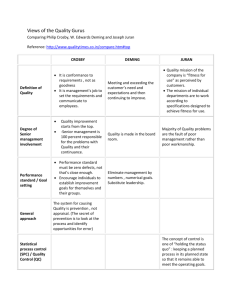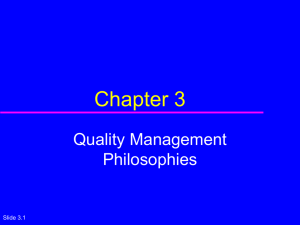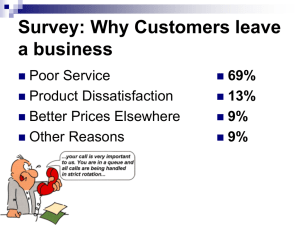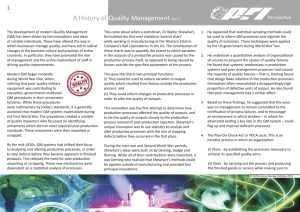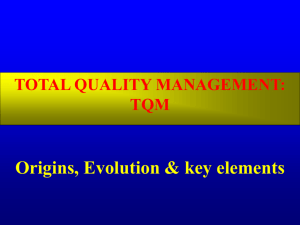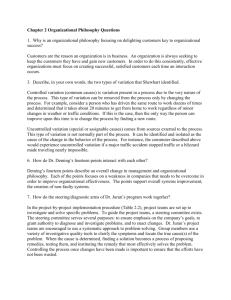Final Research Paper - IET 619 Electronic Portfolio Fall 2013
advertisement
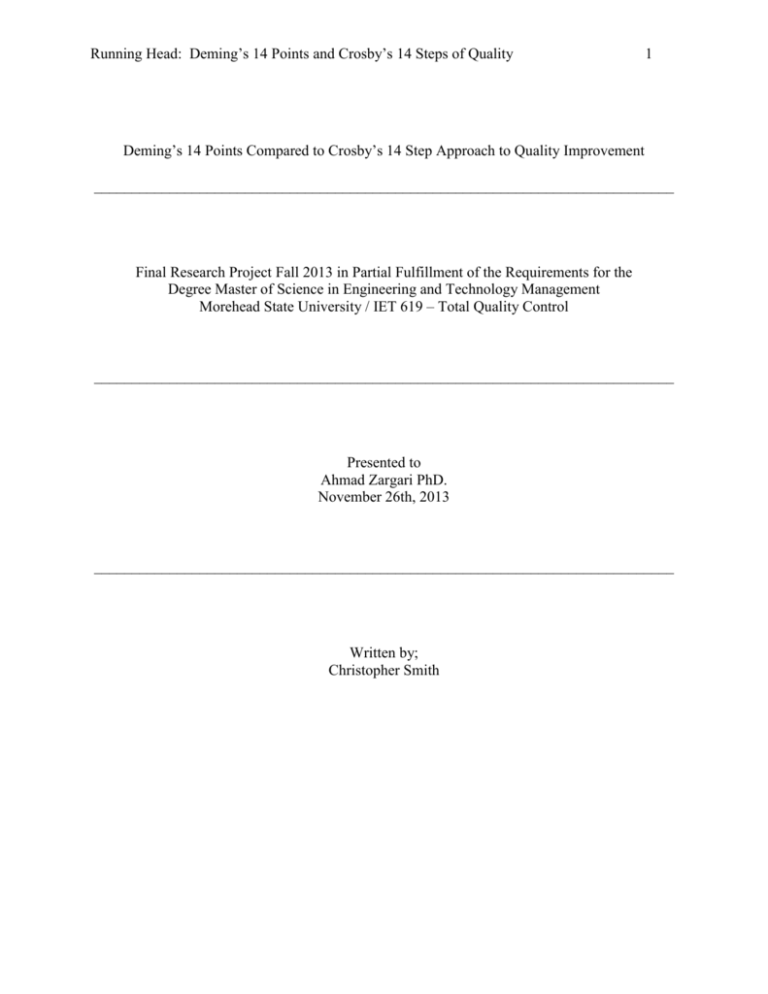
Running Head: Deming’s 14 Points and Crosby’s 14 Steps of Quality 1 Deming’s 14 Points Compared to Crosby’s 14 Step Approach to Quality Improvement _____________________________________________________________________________ Final Research Project Fall 2013 in Partial Fulfillment of the Requirements for the Degree Master of Science in Engineering and Technology Management Morehead State University / IET 619 – Total Quality Control _____________________________________________________________________________ Presented to Ahmad Zargari PhD. November 26th, 2013 _____________________________________________________________________________ Written by; Christopher Smith Deming’s 14 Points and Crosby’s 14 Steps of Quality 2 ABSTRACT In this final research project I will discuss and compare W. Edwards Deming’s 14 point core concepts of Total Quality Management with Phil Crosby’s 14 steps for Quality Improvement. I will attempt to see how they intersect in core values and demonstrate the effectiveness of their approach. I will also discuss my opinions of both philosophies and their effectiveness. Deming’s 14 Points and Crosby’s 14 Steps of Quality 3 INTRODUCTION In the 20th century two pioneers emerged in the quality profession and both had a long lasting effect on how companies developed their quality strategy deployment. W. Edward Deming was probably the more notable of the 2 for his rise in fame helping the Japanese post World War 2 develop their quality systems. Then Phil Crosby’s rise in the corporate world developing his own set of philosophies to unite organizations and train them to have a different perspective on quality management. These two would develop their own sets of a 14 rule creed that would enhance and shape businesses that still have a profound effect today. Let’s take a look at these two sets of rules on see how they can impact and change company culture. Also the difficulties in implementing these strategies are not always black and white. Deming’s 14 Points As mentioned in the introduction W. Edward Deming made a name for himself in postWorld War Japan helping rebuild their quality systems. As one of the fathers of quality he developed the 14 principles of management. These principles help guide companies in Japan to astounding success and helped turn around their manufacturing sector. The principles were the foundation for Total Quality Management. The 14 points are as follows: 1. 2. 3. 4. 5. 6. 7. 8. 9. Create constancy of purpose for improving products and services. Adopt the new philosophy. Cease dependence on inspection to achieve quality. End the practice of awarding business on price alone; instead, minimize total cost by working with a single supplier. Improve constantly and forever every process for planning, production and service. Institute training on the job. Adopt and institute leadership. Drive out fear. Break down barriers between staff areas. Deming’s 14 Points and Crosby’s 14 Steps of Quality 4 10. Eliminate slogans, exhortations and targets for the workforce. 11. Eliminate numerical quotas for the workforce and numerical goals for management. 12. Remove barriers that rob people of pride of workmanship, and eliminate the annual rating or merit system. 13. Institute a vigorous program of education and self-improvement for everyone. 14. Put everybody in the company to work accomplishing the transformation. (Taken from: https://asq.org/learn-about-quality/total-quality-management/overview/demingpoints.html) These guidelines were very different and placed a major emphasis on management and supervision. His emphasis placed responsibility on management to set the tone for a quality culture not just lip service. Constant improvement, stop awarding business to the lowest bidders, interdepartmental cooperation, driving out fear in the workforce were some major examples of his principles that were radically different. His PDCA is also a basic foundation of his teachings that is still the foundation of many quality systems around the globe today. His ideas were very simple but difficult to comprehend with management of the time and even today. After he returned to the Unites States Ford Motor Company recruited his services due to lost market share from Japan and their superior quality. Little did they understand he placed 85% of the blame squarely on management’s shoulders. He stated that they have to change their corporate culture and revise their quality management strategy or they would continue to hemorrhage money and market share. This helped spawn the Ford Taurus which was a resounding success and is one of the highest selling automobiles of all time. Phil Crosby’s 14 Steps Phillip Crosby was also another well recognized in the US for his quality principles and was a pioneer in the quality movement in the United States. He was in the military and studied Deming’s 14 Points and Crosby’s 14 Steps of Quality 5 medicine. We went to work for several companies and helped establish his Four Absolutes of Quality Management: 1. 2. 3. 4. Quality means conformance to requirements, not goodness. Quality is achieved by prevention, not appraisal. Quality has a performance standard of Zero Defects, not acceptable quality levels. Quality is measured by the Price of Nonconformance™, not indexes. Taken from: (http://www.philipcrosby.com/25years/crosby.html) However he came up with his Fourteen Steps that he created to solicit his teachings that were different than Deming’s in some ways and also similar in their approach. His 14 steps were as follows: 1. Make it clear that management is committed to quality. 2. Set up quality improvement teams with representatives of the team drawn from each department. 3. Identify where current and potential nonconformance problems come from. 4. Evaluate the cost of quality and explain its use as a management tool. 5. Raise the quality awareness and personal concern of all employees. 6. Take actions to correct problems identified through previous steps. 7. Establish a committee for the zero defects program. 8. Train supervisors to actively carry out their part of the quality improvement program. 9. Hold a ‘zero defects day’ to let all employees realize that there has been a change. 10. Encourage individuals to establish improvement goals for themselves and their groups. 11. Encourage employees to communicate to management the obstacles they face in attaining their improvement goals. 12. Recognize and appreciate those who participate. 13. Establish quality councils to communicate on a regular basis. 14. Do it all over again to emphasize that the quality improvement program never ends. Taken from: (http://visionhancer.wordpress.com/2009/12/03/phil-crosby-14-step-approach-forquality-improvement-tqm/) His 14 step approach was also more direct but focused a great deal on a zero defect philosophy. His basic approach also included top management responsibilities but yet also focused on team building. Error proofing and defect prevention was a major emphasis to help Deming’s 14 Points and Crosby’s 14 Steps of Quality 6 achieve the zero defect philosophy. Also he stated that each company should have a companywide zero defect day to promote this mindset. Training was also a major emphasis as well as goal setting to monitor continuous improvement. The Way they Compare and Differ As aforementioned both of these 14 approaches had similarities. They both strongly stated that Management Commitment was paramount in any company wide quality management system. They both understood that if top management is not involved then any quality system is set up for failure. So that being said Leadership was a very key component overall just to get started. They were also very strong in their belief of training and continuous education company wide. They both believed that with a strong foundation of training quality would inherently improve the products being produced. A production work force that is properly trained can galvanize the workforce and help deliver a quality product. Not only training at the shop level but also supervisory and management education was also equally as important. Another key component was that they both believed in was continuous improvement. Utilize the workforce to create ideas to find ways to improve quality and productivity. They both understood that continuous improvement was necessary in the survival of companies with increased competition globally. Also analyzing problems and conducting proper problem solving analysis and corrective action to ensure no reoccurrence was also important. Lastly they had a very high stake in defect prevention. Crosby knew that prevention meant prevention started at the top down and that design should be a focus. Deming also knew this and stated that quality should be built into the product. They both knew and understood that attributes could not be inspected into the product. Deming’s 14 Points and Crosby’s 14 Steps of Quality 7 Although each had many similarities they also had different approaches in their 14 steps. Deming didn’t believe in the philosophy of expecting zero defects. In Deming’s tenth principle he states that companies shouldn’t use slogans, posters demanding zero defects. Yet in Crosby’s 9th step he states that each company should conduct a zero defect day to communicate this belief to the workforce. Deming likewise didn’t believe in numerical targets while Crosby thought goal setting and measuring continuous improvement was necessary. Deming believed that leadership and stable processes would lead to continuous improvement and arbitrary metrics were not necessary. Although they both had 14 approaches Deming’s was much more detailed. His also included the purchasing component which stated not to use the cheapest suppliers to make business decisions on procurement. He understood this was a dangerous practice and that poor quality from suppliers could affect productivity or worse pass through to the end user. Deming also understood that departments often had barriers and he knew that they should work together. Fear often was a major culprit with cooperation between departments and he knew that this component should be driven out of the workplace. This mean positive collaboration would lead to better communication between departments and help better serve the companies quality objectives and help the consumer. One last thing Deming understood that the world was in the dawn of a global economy and that if companies didn’t adapt they wouldn’t stay in business. If you read his first 2 principles it is clear he knew that if change in corporate culture was not accepted they simply wouldn’t survive. Mistakes had to be reduced and the old Western style of management had to become a thing of the past. His vision when he created this far exceeded anyone in the industry and why I believe he truly is the father of Total Quality Management. Deming’s 14 Points and Crosby’s 14 Steps of Quality 8 Are these Philosophies Used and are they Effective? When researching this topic it appears that the Deming Philosophy is much harder for companies to comprehend and maintain the focus and commitment required for upper management. After his death in 1993 his philosophy has faded and had been replaced by different management systems such as Six Sigma and Lean Manufacturing. Merit based systems are gaining more and more popularity with all companies to ensure the best workers get the best compensation. It has been very difficult since his passing for executives to grasp his overall teachings. With no merit system or setting objectives and targets it goes against many of the teachings at university business schools. There is no clear cut guidelines except improve the processes and provide leadership based on wisdom. Many managers today use a specific schematic taught in business schools around the world in order to achieve success. He truly believed that if progress was being made on quality that productivity and quality would continue to improve. However it is difficult to comprehend what “improvement” means if it’s not being measured? He also based his improvement more on statistical analysis of problems and a more scientific based approach to problem solving. Almost to an organic level where companies are simply a working system or engine. With Crosby’s ideas they are more traditional to today’s business strategies for quality improvement. With management commitment, quality teams, and measurements of process improvement it is a more systematic way for each company to execute quality objectives and be able to measure success. With focus on continuous improvements and zero defect prevention initiatives it is a clear cut favorite based on my experience that companies can succeed using his roadmap. Deming’s 14 Points and Crosby’s 14 Steps of Quality 9 The cost of quality is also an important strategy with Crosby’s teachings. A company must measure and evaluate its cost of poor quality caused by nonconformances. He also states that quality is either “present or not present”. Quality is also defined by the customer regardless of specifications. Based on those customer requirements is zero defects philosophy being utilized to reduce or eliminate these defects? Conclusion When looking at both men it’s clear they were pioneers in their innovative ability to reshape how we view quality management. Although there were clear differences both were visionaries and successful. Deming was more systematic in his approach and didn’t believe in metrics or award appraisals. Crosby did believe in metrics and recognizing employees for their efforts even though it was a management owned system. Although I think that Deming was ahead of his time and truly had some very valuable philosophies I think some of them are now outdated in today’s corporate reality. I think that rewarding workers on a merit based system is a valued method of motivation. The motivational factors with today’s modern worker needs more of a carrot than reliance on management. This isn’t post war Japan or in many ways companies fighting for their stake in the market place for survival. Although companies have to stay competitive I think they now must take more of an approach that is aligned with Crosby. Companies have to answer to board of directors with Key Process Indicators metrics when reporting to Operations Management. You have to see if your improvements are making an impact on your customer base and internal defects. Without it you have no clear direction. Deming’s 14 Points and Crosby’s 14 Steps of Quality 10 That being said a combination of both philosophies I think fits better. Deming’s insistence on not awarding business to the lowest bidder is a prime example. Many times companies make poor choices which I have seen firsthand solely on pricing. This can lead to costly quality issues internally or externally and cause you to lose trust. They both placed the responsibility at the end of the day on management. I think this focus is paramount in running a successful quality company. Without their backing then any management system can begin to fail the moment it is rolled out to the workforce. Deming’s 14 Points and Crosby’s 14 Steps of Quality 11 Works Cited Phil Crosby : 14 step Approach for Quality Improvement -TQM. (2009, December 3rd). Retrieved November 26th, 2013, from VisionHancer: http://visionhancer.wordpress.com/2009/12/03/phil-crosby-14-step-approach-for-qualityimprovement-tqm/ Biography Philip Crosby. (n.d.). Retrieved November 26th, 2013, from Philip Crosby Assciates: http://www.philipcrosby.com/25years/crosby.html Deming’s 14 Points on Total Quality Management. (n.d.). Retrieved November 26th, 2013, from ASQ: https://asq.org/learn-about-quality/total-quality-management/overview/demingpoints.html Deming’s 14 Principles for Management. (n.d.). Retrieved November 24th, 2013, from Carpenter Group LLC: http://www.quality-improvement-matters.com/14-principles-formanagement.html McInnis, D. (n.d.). W. Edwards Deming of Powell, Wyo.: The Man Who Helped Shape the World. Retrieved November 26th, 2013, from WyoHistory.org: http://www.wyohistory.org/encyclopedia/w-edwards-deming Philip Crosby Associates. (n.d.). Retrieved November 26th, 2013, from We Make Quality Make Sense: http://www.philipcrosby.com/pca/B.Overview.html Stauffer, R. (2010, February 2nd). What happened to the Deming philosophy? Retrieved November 26th, 2013, from Examiner.com: http://www.examiner.com/article/whathappened-to-the-deming-philosophy Suarez, J. G. (1992, July). Three Experts on Quality Management. Retrieved November 26th, 2013, from Department of the Navy TQL Office: http://www.dtic.mil/dtic/tr/fulltext/u2/a256399.pdf
